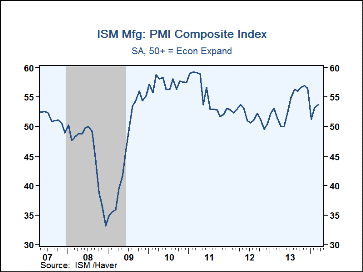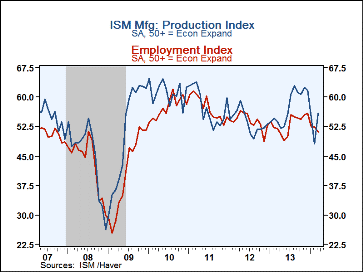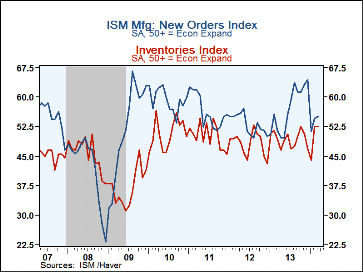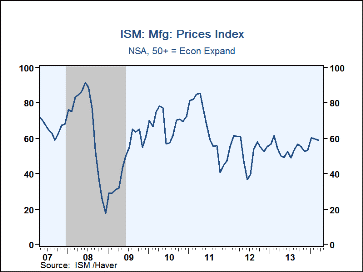 Global| Apr 01 2014
Global| Apr 01 2014U.S. ISM Index Gains to Three-Month High
by:Tom Moeller
|in:Economy in Brief
Summary
Moderate improvement in manufacturing sector activity continued last month following a harsh winter. The Composite Index of Manufacturing Sector Activity from the Institute for Supply Management improved to 53.7 during March from an [...]
Moderate improvement in manufacturing sector activity continued last month following a harsh winter. The Composite Index of Manufacturing Sector Activity from the Institute for Supply Management improved to 53.7 during March from an unrevised 53.2 in February. It was the highest reading since December but remained below the November peak. The latest reading just missed expectations for 54.0 as measured by the Action Economics Forecast Survey. Any figure above 50 indicates an increasing level of activity in the factory sector. During the last ten years, there has been a 76% correlation between the ISM index and the q/q change in real GDP.
A sharp recovery in production to 55.9 accounted for most of the gain in the total index while new orders rose moderately to 55.1. Other component indictors remained weak as the inventories figure was unchanged at 52.5. To the downside, the supplier deliveries index fell to 54.0, indicating the quickest delivery speeds since December. The employment reading fell moderately to 51.1. During the last ten years there has been an 88% correlation between the employment index and the m/m change in factory payrolls. The new export orders index improved to 55.5, the highest level since November, and the imports index gained to 54.5, but was below the August high of 58.0.
The prices paid index series slipped again to 59.0 but remained near the highest level since February 2013. Twenty eight percent of firms raised prices while ten percent lowered them. During the last ten years there has been a 67% correlation between the index and the m/m change in the intermediate producer price index.
The figures from the Institute For Supply Management (ISM) are diffusion indexes and can be found in Haver's USECON database. The expectations number is in the AS1REPNA database.
Thoughts on Accommodative Monetary Policy, Inflation and Financial Instability is the title of last week's speech by Chicago Fed President Charles Evans and it is available here.
| ISM Mfg | Mar | Feb | Jan | Mar'13 | 2013 | 2012 | 2011 |
|---|---|---|---|---|---|---|---|
| Composite Index | 53.7 | 53.2 | 51.3 | 51.5 | 53.9 | 51.8 | 55.2 |
| New Orders | 55.1 | 54.5 | 51.2 | 51.7 | 57.2 | 53.1 | 56.4 |
| Production | 55.9 | 48.2 | 54.8 | 53.9 | 57.7 | 53.8 | 57.4 |
| Employment | 51.1 | 52.3 | 52.3 | 52.1 | 53.2 | 53.8 | 57.4 |
| Supplier Deliveries | 54.0 | 58.5 | 54.3 | 50.4 | 51.9 | 50.0 | 54.7 |
| Inventories | 52.5 | 52.5 | 44.0 | 49.5 | 49.4 | 48.2 | 50.1 |
| Prices Paid Index (NSA) | 59.0 | 60.0 | 60.5 | 54.5 | 53.8 | 53.2 | 65.2 |
Tom Moeller
AuthorMore in Author Profile »Prior to joining Haver Analytics in 2000, Mr. Moeller worked as the Economist at Chancellor Capital Management from 1985 to 1999. There, he developed comprehensive economic forecasts and interpreted economic data for equity and fixed income portfolio managers. Also at Chancellor, Mr. Moeller worked as an equity analyst and was responsible for researching and rating companies in the economically sensitive automobile and housing industries for investment in Chancellor’s equity portfolio. Prior to joining Chancellor, Mr. Moeller was an Economist at Citibank from 1979 to 1984. He also analyzed pricing behavior in the metals industry for the Council on Wage and Price Stability in Washington, D.C. In 1999, Mr. Moeller received the award for most accurate forecast from the Forecasters' Club of New York. From 1990 to 1992 he was President of the New York Association for Business Economists. Mr. Moeller earned an M.B.A. in Finance from Fordham University, where he graduated in 1987. He holds a Bachelor of Arts in Economics from George Washington University.










